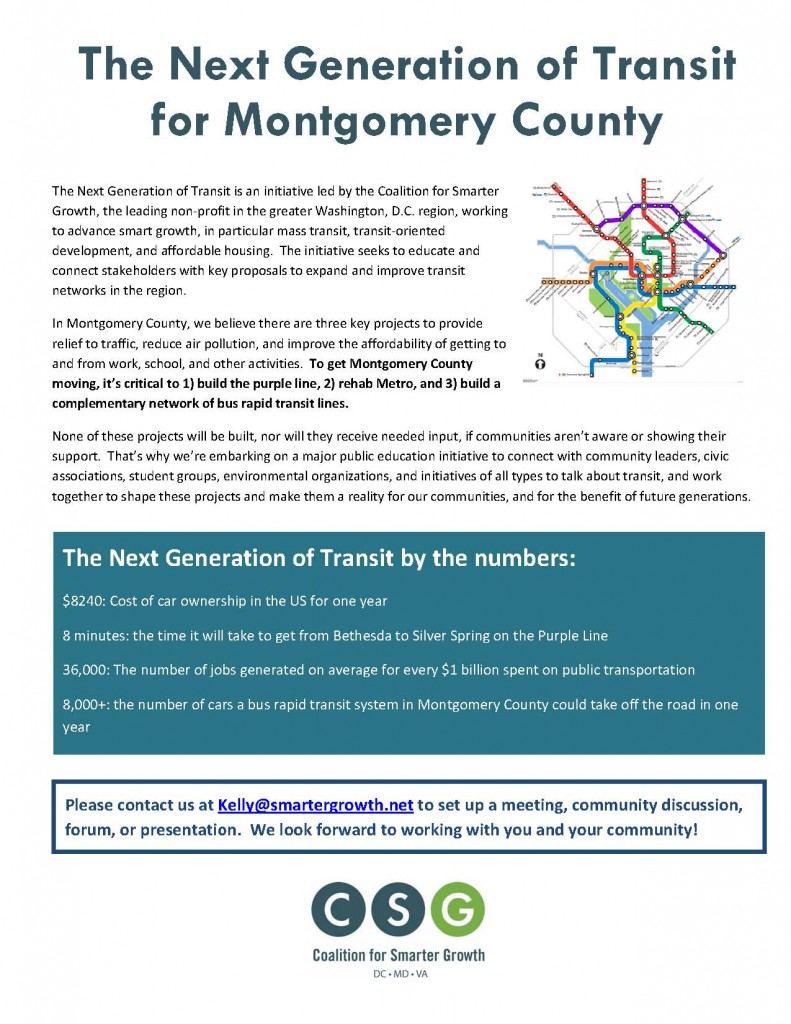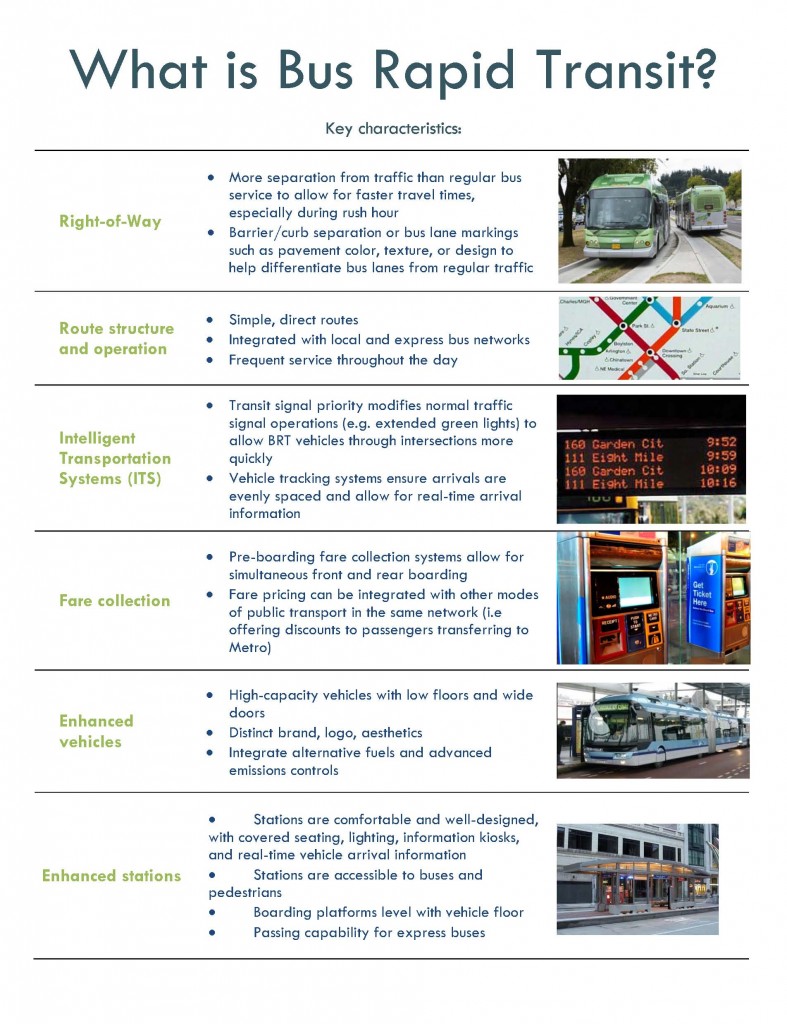On the heels of a report suggesting Montgomery County’s Bus Rapid Transit plans are too ambitious, county planners are recommending reducing the number of lines and using dedicated bus lanes across a smaller portion of the system.
They presented these recommendations last night at a forum hosted by the Coalition for Smarter Growth, “The Next Generation of Transit,” which discussed how the county needs to expand its transit network.
Geoff Anderson from Smart Growth America talked about the social, economic and environmental benefits of public transit and compact, walkable development, while County Councilmember Roger Berliner discussed how transit is integral to attracting young people and entrepreneurs to the county. Mike Madden, project manager for the Maryland Transit Administration, offered a quick update on the Purple Line.
However, the biggest news came from Larry Cole, transportation planner with the Montgomery County Planning Department. Cole presented the latest recommendations for a countywide Bus Rapid Transit network, which would become part of a master plan for future transit expansion.
The county has been studying BRT since 2008, though a recently-released study from the Institute for Transportation and Development Policy, considered to be international experts on BRT, argues that it may not work in all parts of the county.
Planners looked at current land use and travel habits, along with changes proposed in the county’s existing plans, and compared different scenarios for building BRT. They found that while a larger system would draw more riders and reduce driving, physical and economic constraints made a smaller network more feasible.

BRT corridors Montgomery County planners currently recommend. Click here to see their proposal from last November.

The approximate corridors ITDP recommends.The Planning Department’s latest proposal is for a 79-mile network with two phases. It would have 8 routes, on Route 355, Colesville Road/Columbia Pike, Georgia Avenue, New Hampshire Avenue, Randolph Road, Veirs Mill Road, University Boulevard, and the North Bethesda Transitway. It’s a smaller system than previous proposals, but it’s still more than the 4-route system ITDP favors.
Buses would run in mixed traffic on many corridors just as they do today. Last November, Cole suggested that in order to give buses their own dedicated lanes, considered a must-have for successful BRT, space may need to be taken from cars.
Buses would have dedicated lanes in the median on all of Route 355 between Friendship Heights and Clarksburg, where it will support the redevelopment of White Flint and other areas along the corridor, along with portions of Georgia Avenue, New Hampshire Avenue, and Columbia Pike. Combined, these sections make up 31 miles of the system.
On other roads, like Veirs Mill Road and Randolph Road, buses would travel in a single-lane median that would change directions based on rush hour traffic, in “managed lanes” where buses would have some priority over other vehicles, or in mixed traffic.
Cole cited “difficult operational issues” for places where buses wouldn’t get their own lanes, such as Columbia Pike and Colesville Road south of Lockwood Drive in Silver Spring. Though the corridor has six lanes and is home to some of the most heavily-used bus routes in suburban Maryland, homeowners in Four Corners have expressed opposition to taking away lanes from cars at several public meetings, including this one.
Instead, Lockwood Drive, a two-lane road roughly parallel to Columbia Pike and lined with apartment buildings, would be widened to give buses their own lanes, though it doesn’t go all the way to downtown Silver Spring.
“Is the desire [for transit on Colesville and Columbia] there? Yes,” said Cole. “Is the ridership high enough to justify taking a lane? Yes. When we looked at how that would actually work, we decided we needed additional study.”

Buses would run in mixed traffic on Colesville Road and Georgia Avenue in downtown Silver Spring. Photo by the author.Though Montgomery County’s Bus Rapid Transit plans are being trimmed down, they’re moving in the right direction. ITDP recommended that the county focus on areas where transit use is already high, which the 8 routes as proposed do cover. It’s also good to focus on the right solution for the right area, allowing limited resources to be spent where they’re most needed.
At the same time, we can’t fall prey to “BRT creep,” when BRT systems gradually get watered down throughout the design process to the point where they stop being significant steps forward for transit. County planners need to take a stand even when there’s some opposition.
It’s good that they’ve stood by dedicated lanes on Route 355 even in areas like downtown Bethesda and White Flint where space may have be taken from cars, but it’s disappointing that they’ve chosen not to endorse doing the same on equally-constrained Georgia Avenue or Colesville Road in Silver Spring.
Transit is most effective when it can give riders a reliable commute, and buses simply can’t do that when they’re stuck in traffic with everyone else. And without reliable transit, our region’s growth and prosperity is at risk.
Stewart Schwartz, executive director of the Coalition for Smarter Growth, echoed these concerns at the meeting. “We have to make some hard choices,” he said. “We’ve got to figure out a better way to grow. If we do it without adding transit and without adding more walkable neighborhoods, we will just die in our traffic.”
Planners are currently working on a draft of the Countywide Transit Corridors Functional Master Plan, which they will present to the Planning Board in March. In May, the board will hold public hearings before taking a vote later this spring. If the Planning Board and later the County Council approve, the county will start doing more detailed studies in addition to preliminary engineering for the Bus Rapid Transit network.
Photos courtesy of Dan Reed.



